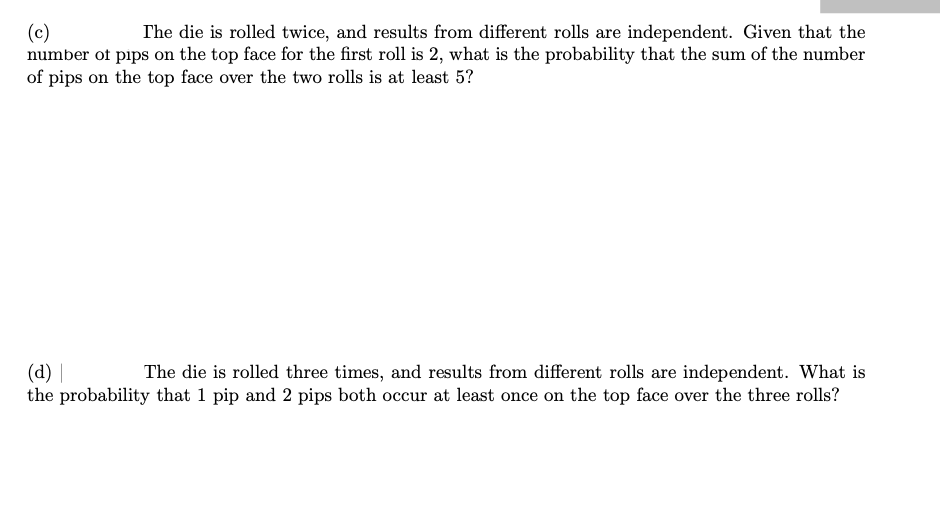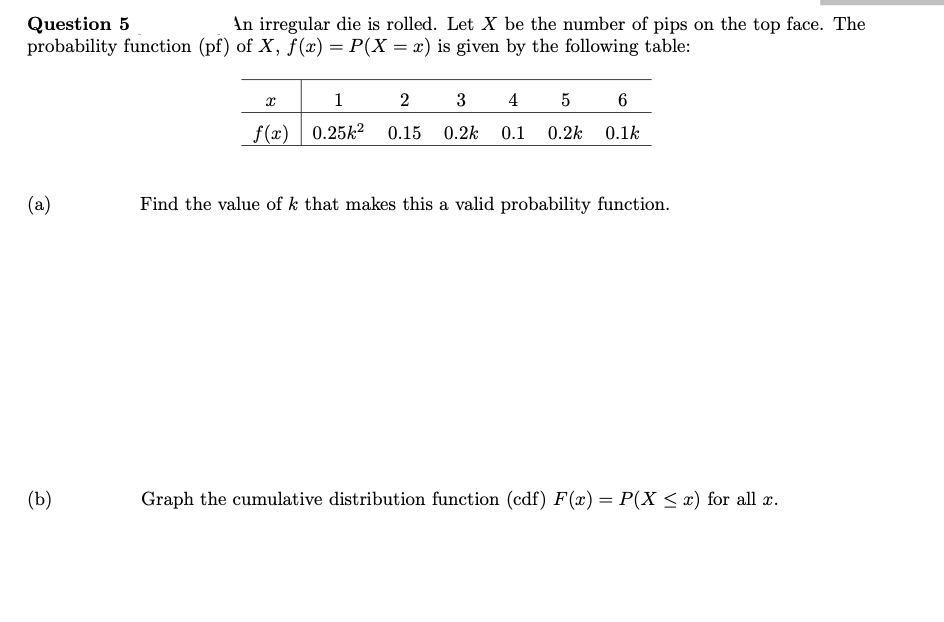(c) number of pips on the top face for the first roll is 2, what is the probability that the sum of the number of pips on the top face over the two rolls is at least 5? The die is rolled twice, and results from different rolls are independent. Given that the
(c) number of pips on the top face for the first roll is 2, what is the probability that the sum of the number of pips on the top face over the two rolls is at least 5? The die is rolled twice, and results from different rolls are independent. Given that the
Algebra & Trigonometry with Analytic Geometry
13th Edition
ISBN:9781133382119
Author:Swokowski
Publisher:Swokowski
Chapter10: Sequences, Series, And Probability
Section10.8: Probability
Problem 31E
Related questions
Question
Solve c,d

Transcribed Image Text:(c)
number of pips on the top face for the first roll is 2, what is the probability that the sum of the number
of pips on the top face over the two rolls is at least 5?
The die is rolled twice, and results from different rolls are independent. Given that the
(d) |
the probability that 1 pip and 2 pips both occur at least once on the top face over the three rolls?
The die is rolled three times, and results from different rolls are independent. What is

Transcribed Image Text:Question 5
probability function (pf) of X, f(x) = P(X = x) is given by the following table:
An irregular die is rolled. Let X be the number of pips on the top face. The
1
2
4
_f(x) | 0.25k²
0.15
0.2k
0.1
0.2k
0.1k
(a)
Find the value of k that makes this a valid probability function.
(b)
Graph the cumulative distribution function (cdf) F(x) = P(X < x) for all x.
Expert Solution
This question has been solved!
Explore an expertly crafted, step-by-step solution for a thorough understanding of key concepts.
Step by step
Solved in 2 steps

Recommended textbooks for you

Algebra & Trigonometry with Analytic Geometry
Algebra
ISBN:
9781133382119
Author:
Swokowski
Publisher:
Cengage

College Algebra
Algebra
ISBN:
9781305115545
Author:
James Stewart, Lothar Redlin, Saleem Watson
Publisher:
Cengage Learning

Algebra and Trigonometry (MindTap Course List)
Algebra
ISBN:
9781305071742
Author:
James Stewart, Lothar Redlin, Saleem Watson
Publisher:
Cengage Learning

Algebra & Trigonometry with Analytic Geometry
Algebra
ISBN:
9781133382119
Author:
Swokowski
Publisher:
Cengage

College Algebra
Algebra
ISBN:
9781305115545
Author:
James Stewart, Lothar Redlin, Saleem Watson
Publisher:
Cengage Learning

Algebra and Trigonometry (MindTap Course List)
Algebra
ISBN:
9781305071742
Author:
James Stewart, Lothar Redlin, Saleem Watson
Publisher:
Cengage Learning